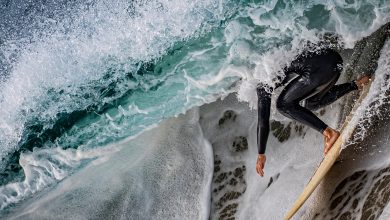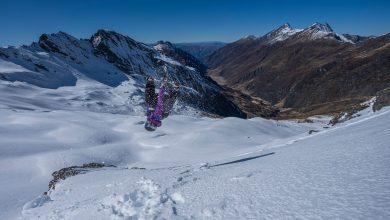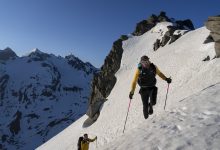
Words and photos by Derek Cheng
We woke to the demoralising sound of rain drumming the tarmac. An early start was critical to tackle the final day – 226km and more than 3000m of elevation gain – of our cycle-tour from Wellington to Wanaka, but the comfort of a blanket is always amplified against a backdrop of a downpour.
My sister Judy and I eventually forced our aching bodies up, organised ourselves, and stared into the dismal, wet morning from the comfort of our warm room. Twenty eight kilometres of eternal dampness and wind gusts lay between us and breakfast at the South Westland Salmon Farm Cafe.
The first step is often the hardest. Once we started pedalling, the blood began flowing as something resembling fluidity tried to emerge.
Water sneaks into the most unlikely of places after an hour of cycling in the rain. The relief when we arrived at the cafe soon evaporated when we were told that the EFTPOS system was down and, having no cash, they would not serve us. The thought of pedalling another wet, cold 60km to Haast on an empty stomach was more than deflating.

But this was not the first time we had encountered the Stone Age when it came to payment on the West Coast, and Judy quickly persuaded staff to allow us a bank transfer over WiFi. The bowl of sugary, warm porridge that followed was, quite simply, a redemptive lifeline.
A check of the forecast showed no respite – up to 10mm an hour – as we considered a dispiriting three-hour ride to Haast. As blustery rain swept onto the deck outside, a discussion ensued about whether to call the cavalry in Wanaka to come and collect us.
The idea of cycle-touring had always appealed, but only ever as a fantasy of spectacular, sunny days through the most pristine settings. I had never embarked on such an adventure because the inevitable reality check would, no doubt, come in the form of rain and violent headwinds.

But a brief window of time and a strong dose of ambition led to a plan to follow 1000km of the Tour. It follows mountain bike tracks, seldom-used sealed and gravel roads and, where they’re the only option, state highways, all wrapped in warm, South Island hospitality. But it was going to be gruelling; the most I had ridden in one day was 120km, which had only been three and a half hours on a road bike.
Following sage advice from more experienced riders, my sister included, we armed ourselves with cyclocross bikes and carried little else besides a change of clothes, bike-repair stuff, a first-aid kit and the all-important, chafe-guarding butt-butter. Booking hotels meant we could leave tents and sleeping bags behind.
A still, calm morning greeted us as we biked off the ferry in Picton and onto a paved road that meanders along the coastline and through a series of paradisal bays. Our first stop, at Havelock, entrenched a pattern that would last the whole journey: lots of eating and lots of coffee. Our bodies would become temples of efficiency, processing five to six meals a day.
The first day’s challenge was the Maungatapu Track, a steep mountain bike trail that crosses the densely-forested hills of the Bryant Range. The 1084m-climb was three times more than anything I had ridden, and the gravel was so unforgiving in places that we were forced to dismount and walk. But the absence of city bustle and the tranquillity of lush South Island landscapes were instantly enriching.

It was only early afternoon by the time we rolled into Nelson, so we cancelled our booked room and continued down a cycle trail along the coast, through city parks and alongside a river into the tiny hamlet of Wakefield.
Our fatigue must have been easy to discern. “You’ll be right after you get a few beers in ya,” a friendly man said as we arrived. A worker at the bar then kindly offered us pizza slices before we could even order dinner.
Day one: 134km, 1750m elevation gain, seven hours of riding. By 8pm, Judy was dead to the world, four seconds after laying down on her bed.
Heading south over the following days delivered hour after hour of stunning scenery; the pine and eucalyptus on the way to Dovedale Saddle, the verdant mountains of Kahurangi National Park that neighbour the Tadmor Valley, the mossy beech trees that hug the gravel road over Maruia Saddle. And all accessible on a network of quiet, empty roads, the kind you would linger on and take your time, if you were driving.
Just as memorable were the eccentric characters. There was Louise at the Gowan Bank Backpackers, on the edge of Nelson Lakes National Park, who plied us with sandwiches and coffee and offered shelter from incessant sandflies. When her lack of EFTPOS services left us feeling poorly prepared, she simply gave us her account number for a bank transfer, whenever convenient.
Melbournite Rea, with a gentle smile and friendly demeanour, welcomed us in the small settlement of Maruia, where she was revelling in the change of pace from urban life. Though the cafe was closed, she gladly made us toasted sandwiches, and didn’t even charge us for tiramisu because she wasn’t sure how long it had been sitting in the cafe cabinet.
There was the man outside restaurant Panda Xpress in Murchison who, in response to our famished stomachs seeking immediate relief, advised us to seek it “anywhere but here”.
And after a downpour riding into Blackball, population 450, Wendi Wilson nourished us with sweet chai and scones, adding later that the recent rise in the local school roll was good for the town because it “deepened the gene pool”.
Reefton was another of many charming stops where we refilled our stomachs and relaxed our legs. The old mining town has seen a renaissance after John Bougen, who made his fortune after founding Dress Mart, moved there and showered the community in money. The main street is now awash with colourful banners, vibrant cafes and restored heritage buildings.
Reefton had all the typical signs of easy South Island life: homes with spacious lawns and open front doors, barefoot youngsters kicking a rugby ball on the street, and drivers that don’t mind stopping for cyclists.
Our overnight destination, which used to house miners, was owned by a congenial man, Norbert, who spoke in German vowels and invited us to watch him perform an entertaining puppet show in his lounge that evening, featuring an antagonist who could turn straw into gold.
As our journey continued, we soon realised that anticipating a thrilling descent made the uphills less soul-destroying. Some, such as after Braeburn Saddle, were on winding gravel roads that crossed water-filled fords. Others, like the 35km into Reefton, were on sealed highways that delivered exhilarating speed, with wind in our faces, beaming smiles, and eyes wide with elation.
Three steep passes guarded the road into Fox Glacier, each delivering a glorious downhill. So perfect was the final one that, when my chain somehow dislodged, I didn’t bother stopping and just glided into town, coming to a rest next to a young man who had the curiosity to ask: “Why the fuck would you bike when everyone here drives everywhere?”
Having just hit 80kmh on the downhill into Fox Glacier, my response had no hesitation: “Because it’s fucking awesome.”
A similar sentiment accompanied the 132km of The West Coast Wilderness Trail, which traverses magical landscapes on a grade-two mountain bike trail. From Greymouth, flax bushes and cabbage trees line the track as it follows the coastline, offering glimpses of the Tasman Sea crashing onto sandy shores.
The trail rolls inland after the Taramakau River. We cycled in radiant sunshine towards mountains shrouded in ominous mist, passing perfectly flat reservoirs and crossing a boardwalk over wetlands as dragonflies fluttered by. Several times we paused on bridges above jaw-dropping chasms that cut a path through steep gorges to ambient rivers. The trail continued through native bush and up gentle slopes before we realised we were riding through the same spectacular misty mountains we had spied from the coast.
The track is so close to the bushline in places that, on two occasions, the sudden appearance of a scurrying weka forced evasive action that threatened a close encounter between my face and the ground. Other times, the cicada symphony was so loud as to drown out the soothing sound of tyres rolling on gravel.

Through it all, there was this dull ache in our legs that we constantly fought, negotiated with, or tried in vain to ignore. So tired were we when we arrived in the small town of Ross that we went straight into the local dairy and came out with stale pies, somehow failing to see the warm and inviting cafe next door. On New Year’s Eve, having pedalled the longest day-ride in my life for the third time in four days, we were fast asleep well before midnight.
Numbers that seem difficult to comprehend punctuated long days: 139km and 1618m in elevation on day two,122km and 1259m in elevation (the easy day!) on day three; 175km and 1153m in elevation on day four; 204km and 1630m in elevation on day five.
By the time our damp souls came to shiver over a steaming hot bowl of porridge at the Salmon Farm cafe, we seemed to have had a lifetime of experiences, spanning the whole spectrum from adversity to euphoria. Judy had even been stung in the face by a bee the previous day, and simply taken an antihistamine and pushed on.
We had embraced it all. How could we quit and take the easy way out now?
When we hit the road again, we came to a series of climbs. At the top of the first one, I reached a saturation point where you no longer really notice if you’re getting any wetter. Time seemed to slow as murky clouds hung heavily, cutting visibility to 20m, as bumper to bumper traffic crawled by.
Friends of friends saw us as they drove north and texted the cavalry in Wanaka: “Just saw Derek and Judy, looking like drowning rats.” This triggered a conversation in Wanaka, where it was eventually decided that driving out to pick us up was pointless as it was probably going to be met with stubborn refusal.
Somehow, the difficult conditions made steep descents more intoxicating, hugging corners and chasing cars at high speed as water fizzed off the tarmac. The road eventually levelled out, and we biked across swollen rivers that tumbled out of the rugged mountains. The scenery was eye-catching, but the Hard Antler Bar and Restaurant in Haast was a far more beautiful sight for our wet bodies and sore bums.
We were still soggy as we left Haast with full bellies, but the clouds soon parted to bestow upon us divine sunshine. Reviving, restorative, uplifting sunshine. We had stripped off layers by the time we started the final, long climb over Haast Pass, where another serendipitous moment awaited us.
When we stopped briefly to catch our breath after the steepest section, a random campervan pulled over and out jumped the smiling faces of Angus and Sue Rodwell, from Melbourne. These complete strangers showered us in encouragement and congratulations, as well as a banana each and a handful of the most perfect snack: lolly snakes.
It was the ideal sugar injection for the push to the top, which led into another screamingly awesome downhill. A pleasant surprise awaited us as the river valley opened up to wider plains. A member of the Wanaka cavalry, Callum, had cycled up to join us for the final 70km stretch.
The highway becomes even more gorgeous as it follows the shores of Lake Wanaka and Lake Hawea, which radiate a certain blue that seems to embolden all those who gaze upon it. It was the perfect ending to an epic odyssey, one overflowing with moments of doubt and joy, quirky characters, places steeped in history, and lonely roads through the most sublime scenery – all compelling answers to the eternal question of why anyone would do this.
Counting the previous day, we had been on SH6 for 350kms by the time we hit the southern edge of Lake Hawea, but the journey had one final, exquisite gift. We followed the Hawea River on a twisting, winding dirt track into Wanaka, the wind at our backs, mountains gleaming in the distance, and fields of golden tussock aflame with the last rays of the setting sun.








